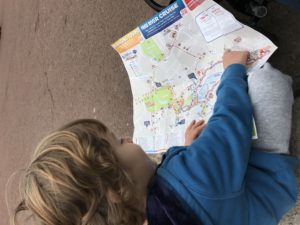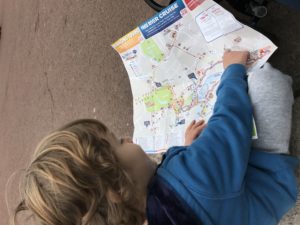I’ve previously shared an outline of the behavior we expect and require from our preschooler when we are at a museum. But it’s important to recognize that having an enjoyable and easy outing is a two-way street.
As parents, we need to set our little ones up for success! A big part of this is having reasonable expectations in the first place. No child would be able to go along on a lengthy guided tour without making a peep or fidgeting — do not ask them to do something they are not developmentally capable of doing!
Here are a few ideas to consider:
Trend toward the rear of the group. That way, you can hang back if reminders need to be issued. Don’t initiate the hokey pokey, but if you’re in nobody’s way, shifting from foot to foot won’t cause any distraction. Have a fun conversation, and maybe be a little more relaxed on the decibel level, while you’re walking between points of interest so that you can more willingly receive quiet when a docent is talking.
 Alternate periods when their attention is required with some mental and physical down time. Take breaks without needing to fully leave the venue — a few rounds of I-spy from a bench in the atrium can act as a wonderful reset. Water and bathroom breaks can be a big help too.
Alternate periods when their attention is required with some mental and physical down time. Take breaks without needing to fully leave the venue — a few rounds of I-spy from a bench in the atrium can act as a wonderful reset. Water and bathroom breaks can be a big help too.
Get the wiggles out. Consider stopping at a playground either before or afterward to expend energy. And be sure to give them some warning before they need to be fully on their game with best behavior.
Combat hunger and fatigue. These are major enemies — in their own rights and for the crankiness they can cause. If allowable at your destination, bring appropriate snacks and deploy them thoughtfully Don’t go for anything sticky or staining, and try to have contained servings, as opposed to the never-ending dispenser of Cheerios that will ruin lunch and invariably leave a breadcrumb trail behind you.
Nap needs and schedules are widely variant and dependent on personality. Know your kid and use common sense. If you can get them to nap in the stroller, enjoy some time to peruse at your own speed. And since long walks can be tough on little legs, do a little advance planning to try and limit how much unnecessary ground they have to cover. Which entrance you use or staircase you take can make real difference in their endurance.
How do you set your kids up for success when you’re out on the town learning?


